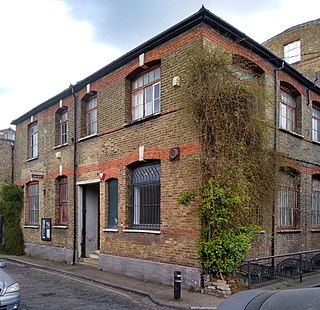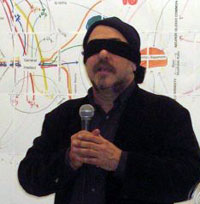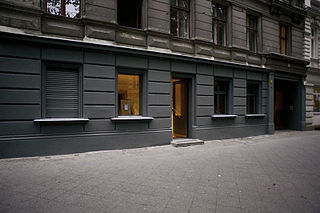Related Research Articles
A chord is in close harmony if its notes are arranged within a narrow range, usually with no more than an octave between the top and bottom notes. In contrast, a chord is in open harmony if there is more than an octave between the top and bottom notes. The more general term spacing describes how far apart the notes in a chord are voiced. A triad in close harmony has compact spacing, while one in open harmony has wider spacing.

The Whitney Biennial is a biennial exhibition of contemporary American art, typically by young and lesser known artists, on display at the Whitney Museum of American Art in New York City, United States. The event began as an annual exhibition in 1932; the first biennial was in 1973. The Whitney show is generally regarded as one of the leading shows in the art world, often setting or leading trends in contemporary art. It helped bring artists like Georgia O'Keeffe, Jackson Pollock, and Jeff Koons to prominence.

The Moscow Biennale of Contemporary Art is one of the most important Russian cultural events and was founded in 2003.
Brad Adkins is an American self-taught artist and curator. In 2002, Chas Bowie of The Portland Mercury declared Adkins "the poster boy of low-rent artwork.", Also in 2002, D.K. Row of The Oregonian listed Adkins as one of ten "artists you don't know, but should." Matthew Stadler of Nest and Clear Cut Press calls Adkins "an orchestrator of the quotidian", "whose interventions turn the everyday into art."

Hans Ulrich Obrist is a Swiss art curator, critic, and historian of art. He is artistic director at the Serpentine Galleries, London. Obrist is the author of The Interview Project, an extensive ongoing project of interviews. He is also co-editor of the Cahiers d'Art review.
Art intervention is an interaction with a previously existing artwork, audience, venue/space or situation. It is in the category of conceptual art and is commonly a form of performance art. It is associated with the Viennese Actionists, the Dada movement and Neo-Dadaists. Stuckists have made extensive use of it to affect perceptions of artworks they oppose and as a protest against existing interventions.
Kenneth Charles Knowlton was an American computer graphics pioneer, artist, mosaicist and portraitist. In 1963, while working at Bell Labs, he developed the BEFLIX programming language for creating bitmap computer-produced movies. In 1966, also at Bell Labs, he and Leon Harmon created the computer artwork Computer Nude .

The Brooklyn Rail is a publication and platform for the arts, culture, humanities, and politics. The Rail is based in Brooklyn, New York. It features in-depth critical essays, fiction, poetry, as well as interviews with artists, critics, and curators, and reviews of art, music, dance, film, books, and theater.

Campbell Works is the creative partnership of artists Neil Taylor and Harriet Murray established in 2004. It runs a programme of contemporary art exhibitions, public engagement projects, publications and education schemes. By initiating and developing collaborative frameworks and creating a platform for new curatorial projects, Campbell Works acts as a meeting point for ideas and explores contextual relationships between art, spaces and people.

Warren Neidich is an American artist who lives in Berlin and Los Angeles. He was a professor at Kunsthochschule Weißensee School of Art, Berlin and visiting scholar at Otis College of Art and Design, Los Angeles.
The Townhouse Gallery was established in 1998 as an independent, non-profit art space in Cairo, Egypt, with a goal of making contemporary arts accessible to all without compromising creative practice. The Townhouse supports artistic work in a wide range of media through exhibitions, residencies for artists and curators, educational initiatives and outreach programs. By establishing local and international relationships, as well as diversifying both the practitioners and audiences of contemporary art, the Townhouse aims to support and expand the knowledge, appreciation and practice of contemporary arts in Egypt and the region.

Archive is a publishing and research platform based in Berlin.
Eric Butcher is a contemporary British abstract painter known for his reductive, processed-based approach.

La Femme à l'Éventail, or Woman with a Fan, is a painting by the French artist Jean Metzinger. The work was exhibited in 1914 at Moderni Umeni, S.V.U. Mánes, Prague. A 1914 photograph taken at the exhibition in Prague was published in the magazine Zlatá Praha showing Woman with a Fan hanging next to another work by Metzinger known as En Canot , 1913. Donated by Mr and Mrs Sigmund Kunstadter in 1959, Woman with a Fan forms part of the permanent collection in Gallery 391B at the Art Institute of Chicago, US.
Christine Y. Kim is an American curator of contemporary art. She is currently the Britton Family Curator-at-Large at Tate. Prior to this post, Kim held the position of Curator of Contemporary Art at the Los Angeles County Museum of Art. Before her appointment at LACMA in 2009, she was Associate Curator at The Studio Museum in Harlem in New York. She is best known for her exhibitions of and publications on artists of color, diasporic and marginalized discourses, and 21st-century technology and artistic practices.
The Hnatyshyn Foundation Visual Arts Awards, the Award for Outstanding Achievement as an Artist and the Award for Curatorial Excellence in Contemporary Art are two annual arts awards of $25,000 and $10,000 that recognize mid-career Canadian visual artists and curators. The Hnatyshyn Foundation is a private charity established by Ray Hnatyshyn, Canada’s 24th Governor General.
Smadar Sheffi is the Chief Curator of the Contemporary Art Center, Ramle – CACR. She is an art critic, researcher of contemporary art and culture, and independent curator. Over past years, she has gained vast experience in curating exhibitions in historical structures, among them the Bialik House Museum, Jerusalem Artists House, Contemporary Art Center, Ramla-CACR, and the Pool of the Arches, Ramla. Dr. Sheffi’s bilingual blog of art criticism and notes on contemporary culture, The Window [1] has been active since 2012.
Cecily Nicholson is a Canadian poet, arts administrator, independent curator, and activist. Originally from Ontario, she is now based in British Columbia. As a writer and a poet, Nicholson has published collections of poetry, contributed to collected literary works, presented public lectures and readings, and collaborated with numerous community organizations. As an arts administrator, she has worked at the Surrey Art Gallery in Surrey, British Columbia, and the artist-run centre Gallery Gachet in Vancouver.
Tina Sauerlaender is a Berlin-based independent curator and writer. She is the co-founder, director and head curator of peer to space, a platform and exhibition hub for curatorial projects founded in Munich, Germany in 2010.
Pilvi Takala is a performance artist presenting candid camera as art. Takala won the Dutch Prix de Rome in 2011 and the Emdash Award in 2013. Her works have been exhibited in various exhibitions worldwide, most recently in London, Aarhus and Glasgow. She is known best for being in time-based media.
References
- 1 2 3 4 5 6 Neidich, Warren. "The Rules of Engagement: EXHIBITION by Warren Neidich | ART LIES: A Contemporary Art Quarterly". www.art-lies.org. Retrieved 2018-03-27.
- ↑ "Mercato dell'Arte: Le tendenze del mercato dell'arte, delle opere ed artisti". ArtEconomy - Il Sole 24 ORE (in Italian). Retrieved 2018-03-27.
- 1 2 3 4 Diana, Artus (2009). "More than the Sum of its Parts" (PDF). Trafo-M.
- ↑ "Berlin Calling: Alexis Knowlton by Mary Jones - BOMB Magazine". bombmagazine.org. Retrieved 2018-03-28.
- ↑ Bajo, Elena (2009-07-08). "Update Contributing Artists as of August 31st, 2009". EXHIBITION. Retrieved 2018-03-27.
- ↑ "Free & Clear: Exhibition and the Free Store | Art21 Magazine". Art21 Magazine. Retrieved 2018-03-27.
- ↑ "William Burroughs, "The Cut Up Method"". www.robertspahr.com. Retrieved 2018-03-27.